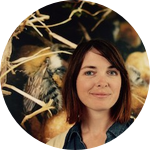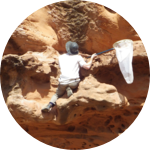About This Project
Bees are vital pollinators, but they face many threats. Unknown to many, most bees spend the majority of their life as larvae, shielded from the environment only by the material they nest in and their nest cells. This project uses a sandstone-excavating bee, Anthophora pueblo, to test how nest substrates differ in their protective ability and whether or not this impacts the larvae themselves. These results have implications for how climate change may affect bees differently based on substrate.
Ask the Scientists
Join The DiscussionWhat is the context of this research?
Deserts are challenging environments that force organisms to adapt or perish. Prior research has tested how bees are impacted by short periods of intense heat (Cane 2011), and proper humidity is necessary for successful development (May 1972), but little is known about how nest material choice alters these factors in natural systems. Bees nest in many substrates, and certain substrates provide better insulation from the environment. As such, females nesting in certain materials may be able to invest less in protecting each egg they lay. We will investigate this possibility by exposing a sandstone-nesting bee, Anthophora pueblo (Orr 2016), to differing lab-controlled environmental regimes that are based on conditions we measure for other nesting materials in the field.
What is the significance of this project?
This experiment will be the first to rigorously characterize the effect of nest substrate choice on temperature and humidity regulation in desert bee larvae. In doing so, this project is an important next step in developing our knowledge of Anthophora pueblo, and the data generated and new nest sites discovered here will prove invaluable for future projects on the conservation status of this unusual species. This research will also expand our knowledge of bees in deserts overall, where bees are most species-rich (Michener 1979). This study also has implications for bee responses to climate change, as deserts and many other environments are expected to become hotter and drier in the future (Dai 2011; Diffenbaugh 2013).
What are the goals of the project?
The recently-described Anthophora pueblo is the ideal system for this study because the sandstone it nests within provides an unusual point of comparison to other locally available substrates, and its desert environment faces both high seasonal temperature variation and low humidity. We will take field readings of temperature and humidity in winter and summer inside available substrates across multiple sites using iButtons. We will collect nest cells the next year and expose the cells to environmental regimes based on the field data for different substrates, using lab incubators. Measures of mass and mortality will be used to judge the effect of these regimes on larval health.
Budget
The majority of the materials required for this study are already available at Utah State University. The only additional items required for this project are the iButton data loggers, which record both temperature and humidity.
The travel budget accounts for a minimum of three trips to and from all field sites. Michael Orr will finance any unforeseen travel costs, including maintenance.
Endorsed by
Meet the Team
Affiliates
Michael Orr
I am a Doctoral Candidate at Utah State, where I study bees with Terry Griswold and James Pitts. My dissertation research involves the taxonomy, systematics, and biogeography of the bee group Anthophora; the mechanisms and effects of specialization on specific host plants; and where and how bees nest, especially in extreme habitats such as in sandstone and on the rim of volcanoes.
Stemming from a lifelong interest in insects, I completed my undergraduate degree in Entomology at Cornell University. There, I worked in Dr. Bryan Danforth’s lab as a member of the Apple Pollinator Project. Furthering my newfound interest in bees, I spent a year before graduate school working as a Smithsonian Institution Collections Intern for Dr. Seán Brady and also as a USGS Contractor to Sam Droege. These positions expanded my knowledge of bees, preparing me for my PhD work at Utah State.
Following my PhD, I plan to continue my studies of Anthophora pueblo by exploring how the resources this bee requires have shaped its ecology and evolution, and how the species may be impacted by threats like climate change.
Terry Griswold
I am a Utah State University Adjunct Professor and a USDA-ARS Research Entomologist in the USDA-ARS National Pollinating Insects Collection.
Additional Information
For more information about my research, please visit my new research website.
Sci-News has posted a video about our work on this species, which includes some of our footage of the bee in action!:
Other media coverage includes:
Daily Mail, Discover Magazine, EOS, Fox News, LiveScience, Reuters, Scientific American, The Wildlife Society, Yahoo
Frequently asked questions:
None yet! Please contact me if you have any questions.
References:
Cane, J.H. & J.L. Neff. 2011. Predicted fates of ground-nesting bees in soil heated by wildfire: Thermal tolerances of life stages and a survey of nesting depths. Biological Conservation 144.
Dai, A. 2011. Drought under global warming: a review. Wiley Interdisciplinary Reviews: Climate Change 2.
Diffenbaugh, N.S. & C.B. Field. 2013. Changes in Ecologically Critical Terrestrial Climate Conditions. Science 341.
May, D.G.K. 1972. Water Uptake during Larval Development of a Sweat Bee, Augochlora pura (Hymenoptera: Apoidea). Journal of the Kansas Entomological Society 45.
Michener, C.D. 1979. Biogeography of the Bees. Annals of the Missouri Botanical Garden 66.
Orr, M.C., T. Griswold, J.P. Pitts, & F.D. Parker. 2016. A new bee species that excavates sandstone nests. Current Biology 26.
Project Backers
- 33Backers
- 64%Funded
- $1,914Total Donations
- $56.29Average Donation


